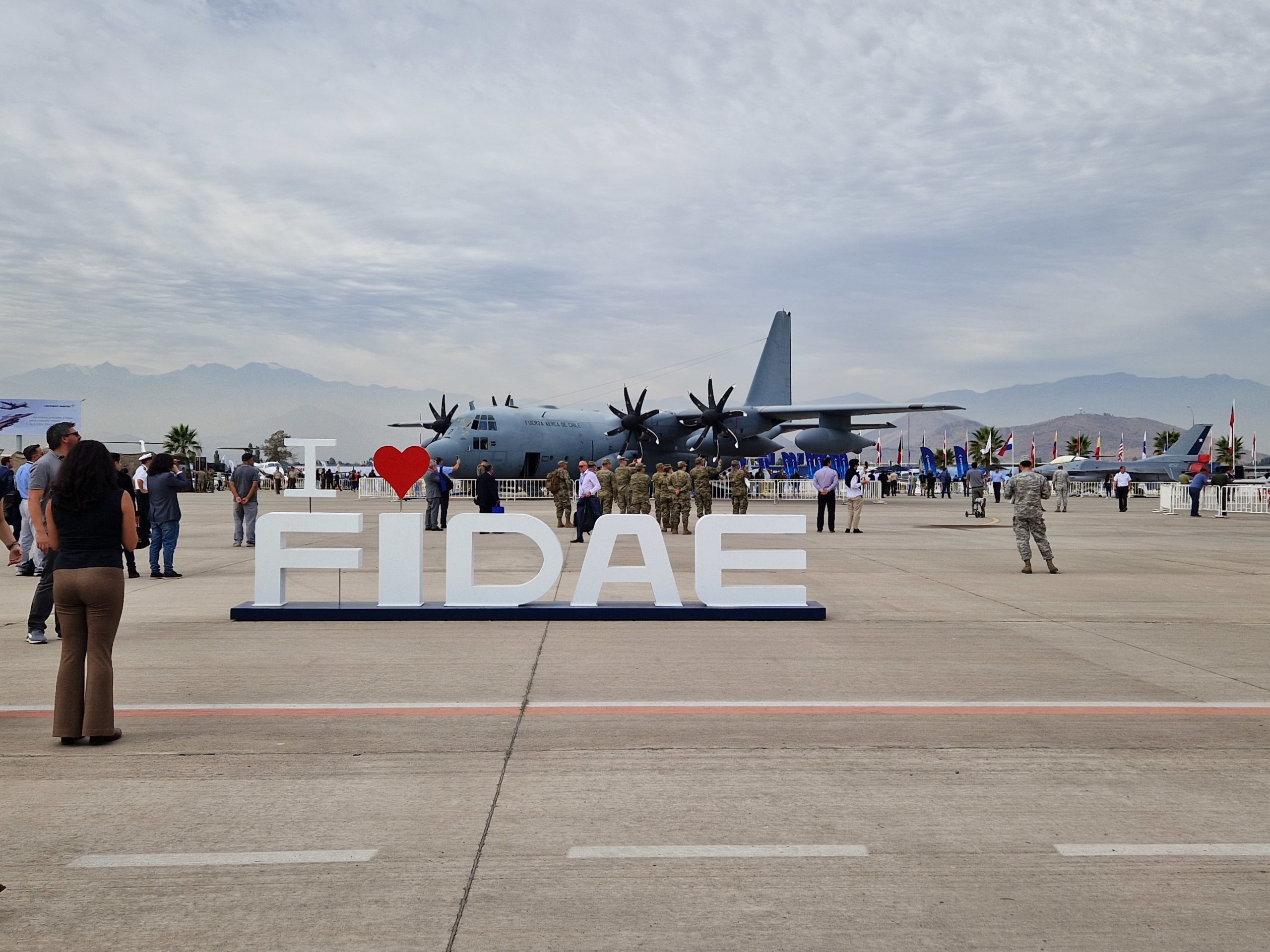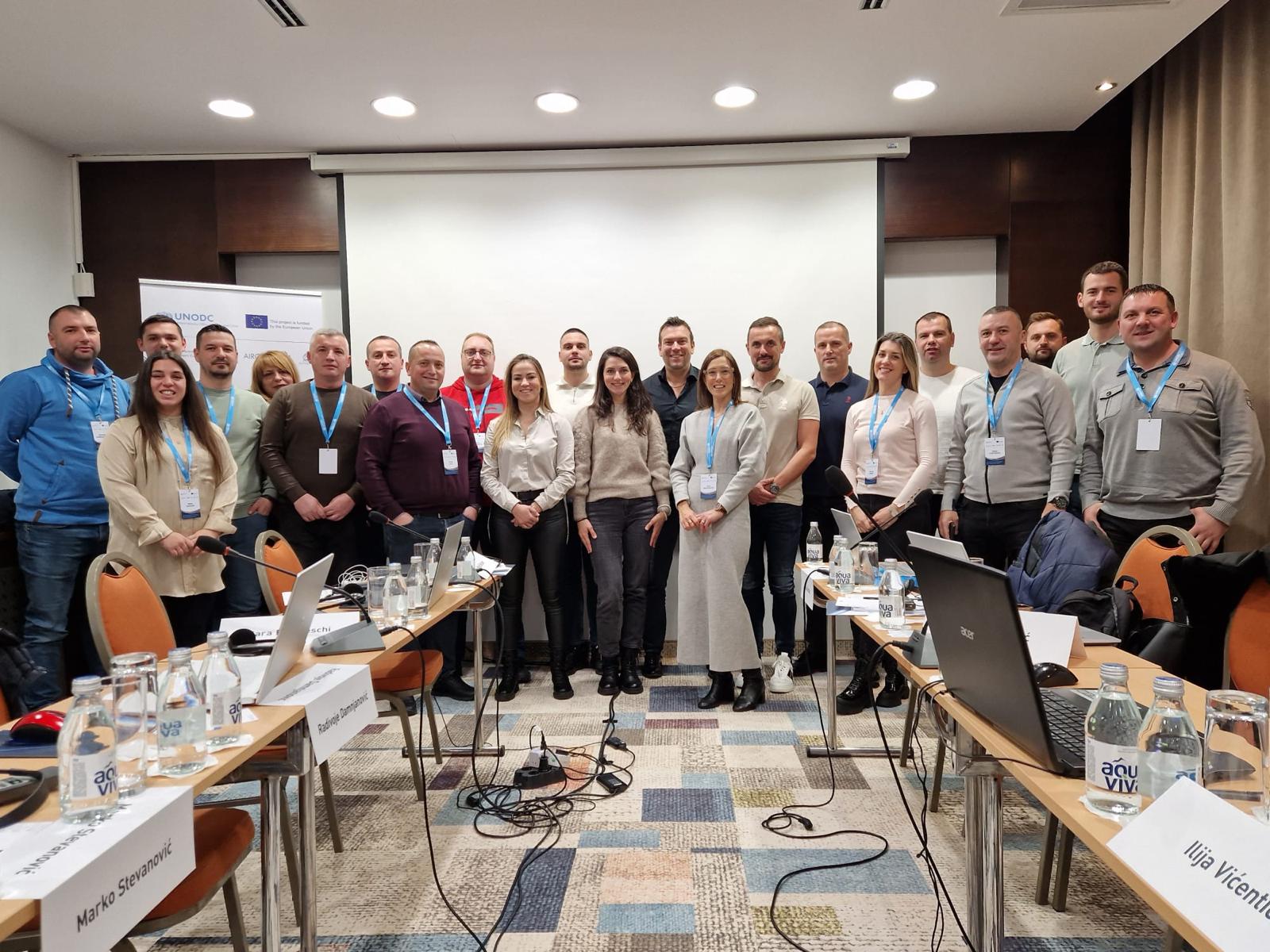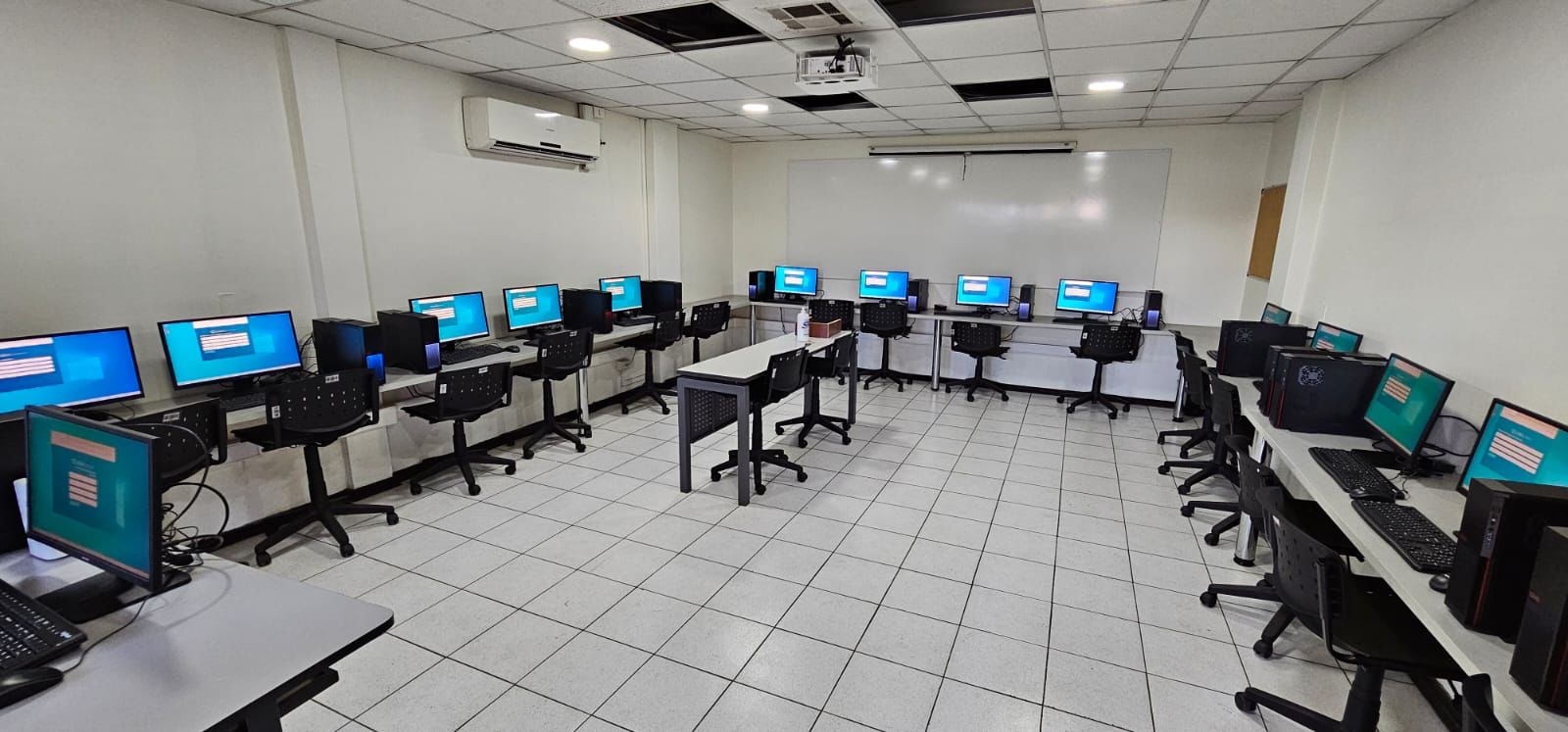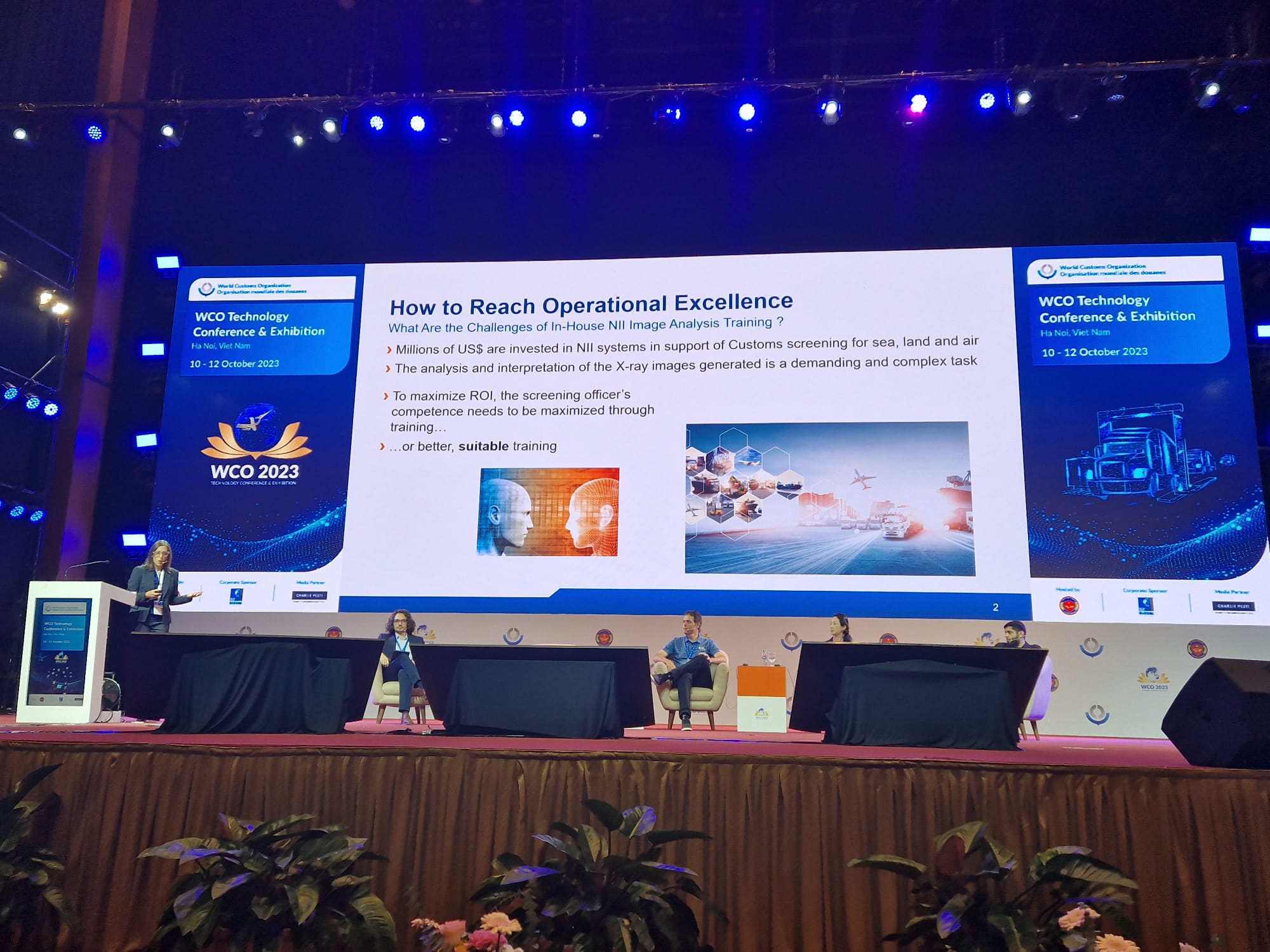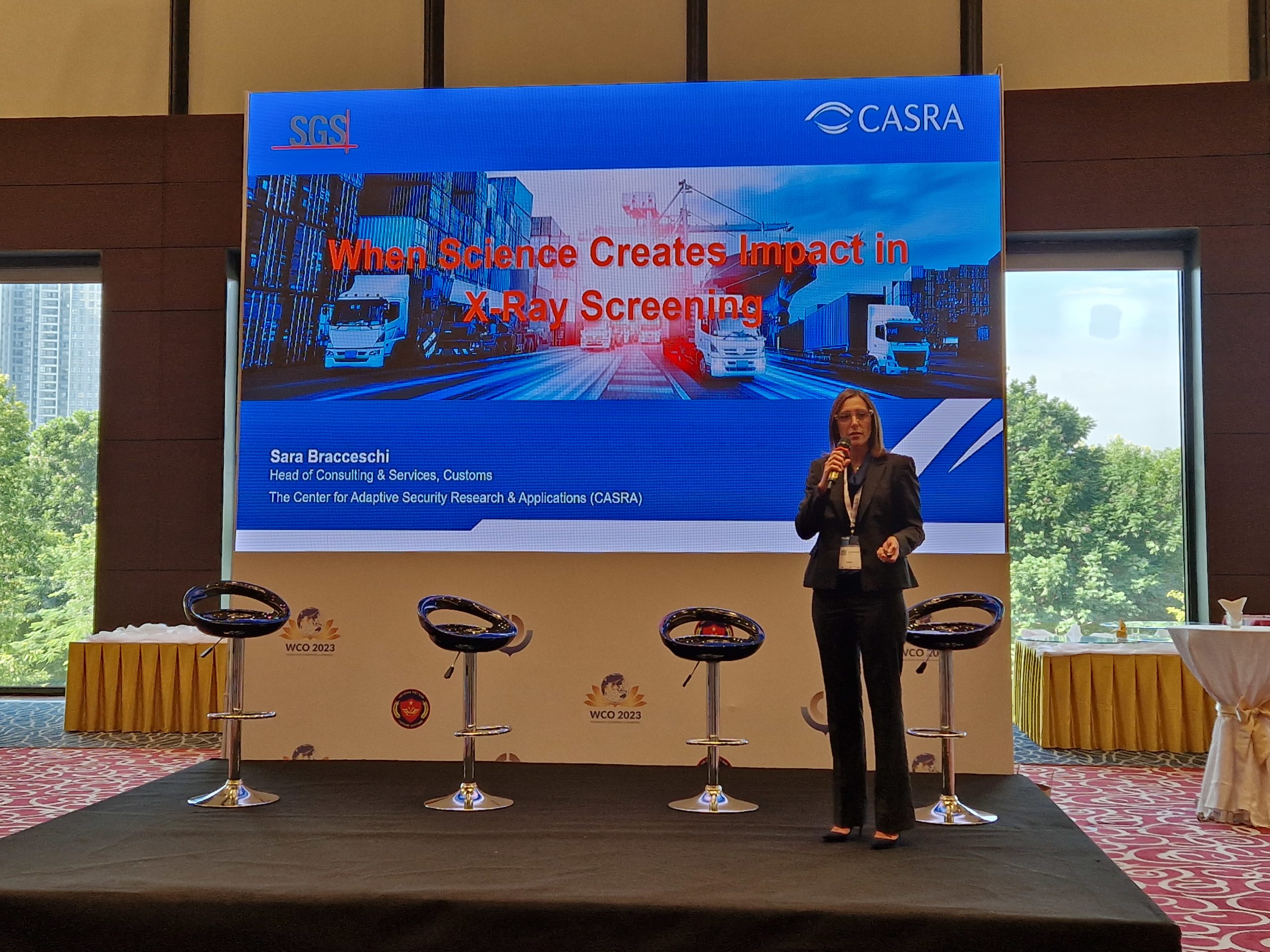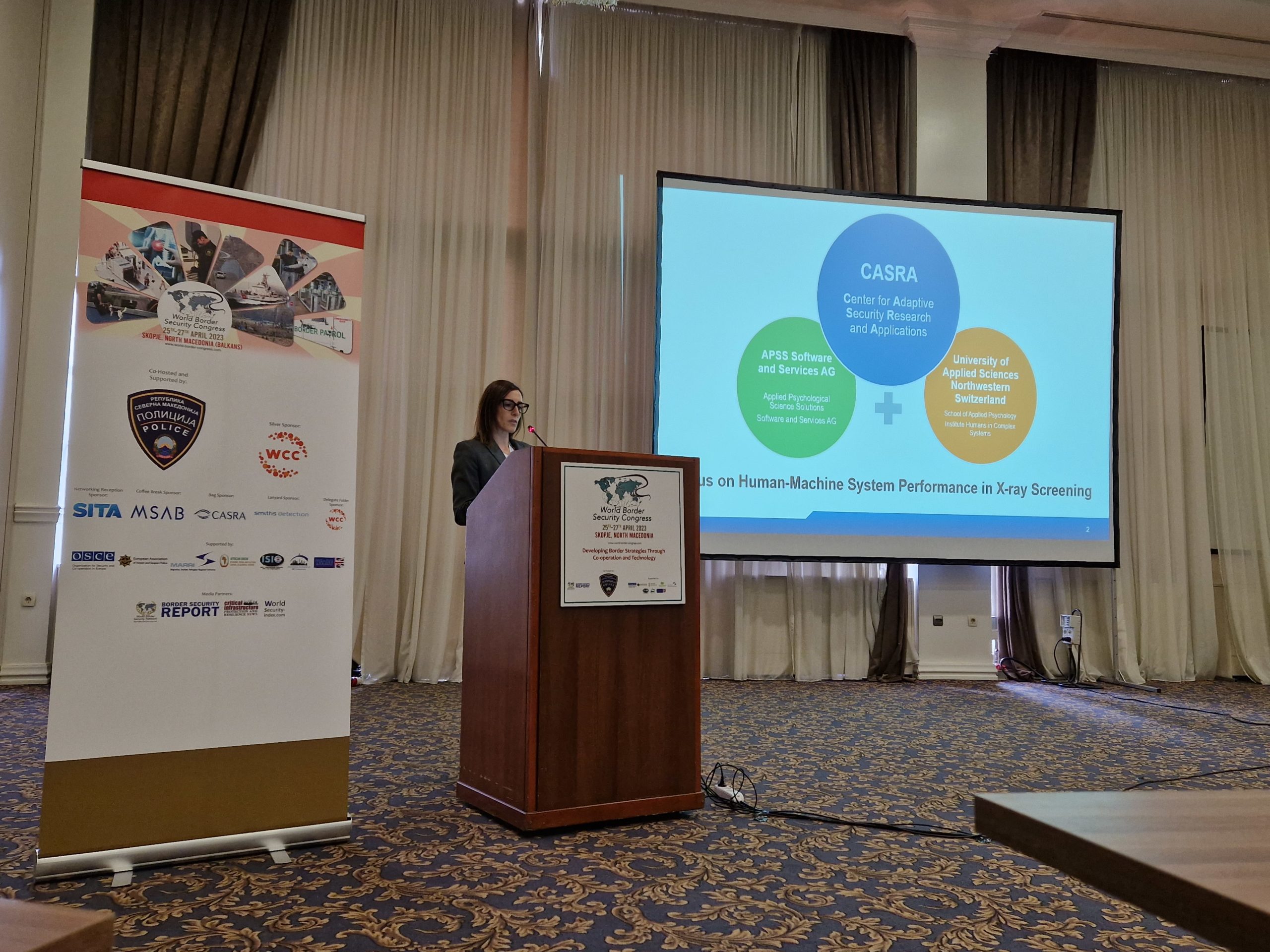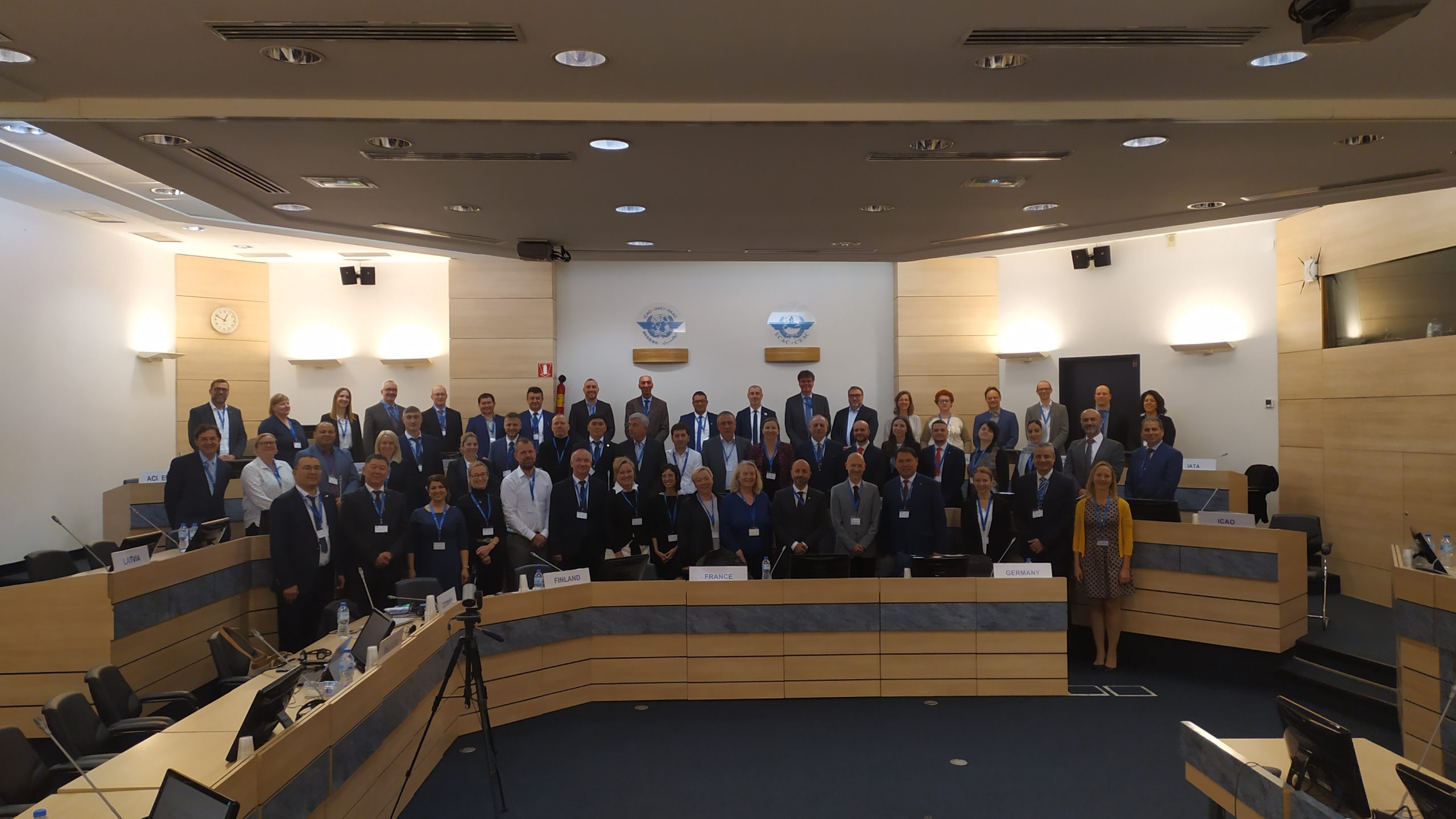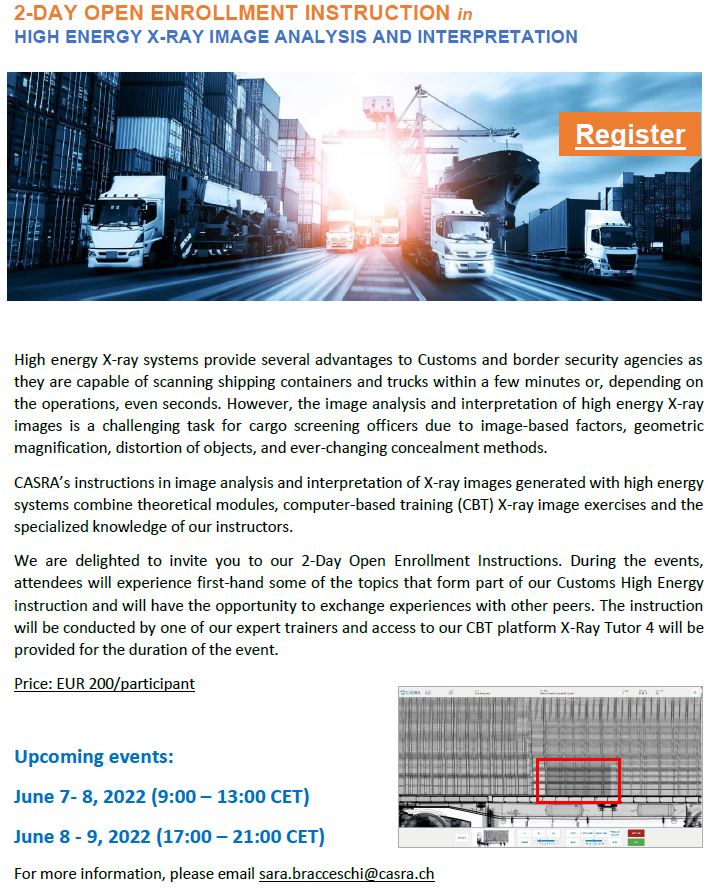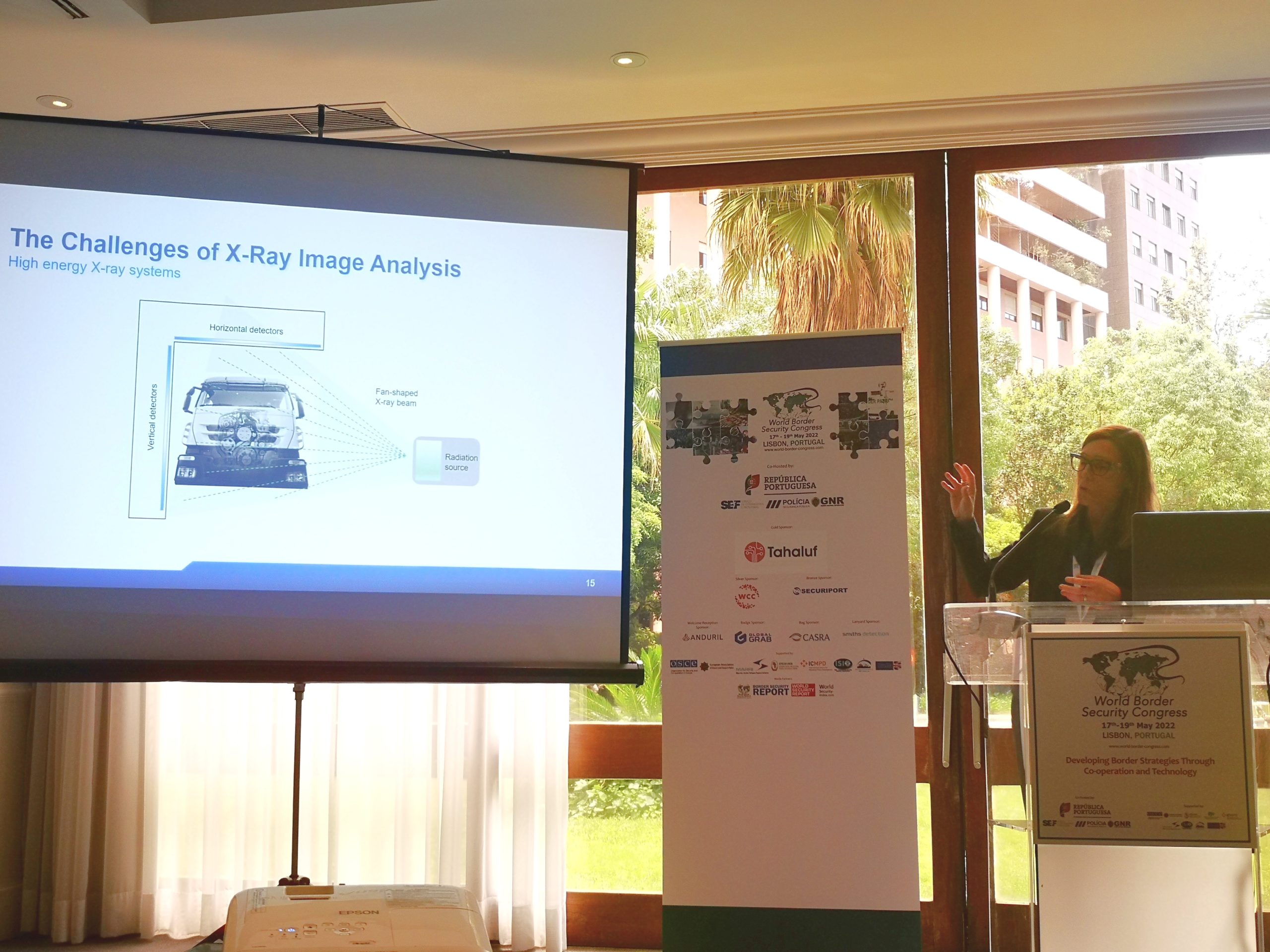News & Newsletter
Latest News
Latest News
More News
September, 2024: Publication on remote versus local cabin baggage screening
Members of CASRA recently published a study in the International Journal of Industrial Ergonomics on remote cabin baggage screening (RCBS) versus traditional screening at the lane, i.e. local cabin baggage screening (LCBS). The study used linear mixed models for analyzing threat image projection (TIP) data from 1706 screeners collected over two years (669’168 TIP events). The results showed better detection of prohibited articles (higher hit rate) and longer processing times in RCBS than in LCBS. In both settings, we found a decrease in the hit rate with increasing time on task, and this decrease was stronger when the task load was high. Interestingly, the effects of work setting, time on task, and task load were relatively small compared with the interindividual differences in performance across screeners. The published paper is available here.
July, 2024: New Issue of the CASRA Newsletter is available now!
Since 2012, we have been publishing newsletters in which we summarize CASRA’s research results and refer to trends in the security sector.
The first article describes the Airport Checkpoint Effectiveness Simulation (ACES), a software we developed for comparing different airport security checkpoints regarding security effectiveness. The second article presents insights into the upcoming relaunch of CASRA’s X-Ray Tutor (XRT), training and testing platform for X-ray screening. This includes a new user interface. For more information, subscribe to our newsletter.
June 2024: CASRA strengthens its presence in Chile
We are thrilled to announce that CASRA, in conjunction with our local partner, has been awarded the tender for X-ray image analysis training by the Chilean Customs! This significant achievement reflects our unwavering commitment to excellence in X-ray screening. As we embark on this new journey, we are eager to collaborate with Chilean customs officials to enhance their screening skills and knowledge, ensuring more secure and efficient customs processes. A big thank you to the Chilean authorities for placing their trust in us. Together, we will set new standards in customs training and security
April, 2024: CASRA visited FIDAE
CASRA had the opportunity to visit FIDAE – FERIA INTERNACIONAL DEL AIRE Y DEL ESPACIO in Santiago de Chile between April 9th – 12th, 2024.
We appreciate the good connections we have been able to make during the exhibition days and look forward to fruitful cooperation.
March 2024: X-Ray Tutor 4 Expert Training with Hamad International Airport
We are pleased to announce the successful completion of a two-day online training session with Hamad International Airport. Using X-Ray Tutor 4 (XRT4) and its Expert licenses, administrators have the ability to create their own training and testing modules. Since 2020, Hamad International Airport has been using CASRA’s computer-based training covering training for cabin and hold baggage screening for dual-view and 3D CT technology.
February 2024: CASRA delivers instruction for UNODC in Belgrade
CASRA closed the year 2023 on a high note, successfully delivering an X-ray image analysis instruction in Belgrade in December 12-15. The instruction was conducted for the UNODC’s AIRCOP / CCP Passenger and Cargo Border Management Team for Southern Europe. We were honored to count among attendees law enforcement and Customs officers from Bosnia and Herzegovina, North Macedonia and Serbia, who showed the highest level of commitment to the training and to learning more about X-ray image analysis and interpretation. We would like to thank UNODC for this important engagement.
More News
September, 2024: Publication on remote versus local cabin baggage screening
Members of CASRA recently published a study in the International Journal of Industrial Ergonomics on remote cabin baggage screening (RCBS) versus traditional screening at the lane, i.e. local cabin baggage screening (LCBS). The study used linear mixed models for analyzing threat image projection (TIP) data from 1706 screeners collected over two years (669’168 TIP events). The results showed better detection of prohibited articles (higher hit rate) and longer processing times in RCBS than in LCBS. In both settings, we found a decrease in the hit rate with increasing time on task, and this decrease was stronger when the task load was high. Interestingly, the effects of work setting, time on task, and task load were relatively small compared with the interindividual differences in performance across screeners. The published paper is available here.
Newsletter Archive
Issue 31 - 2024
AIRPORT CHECKPOINT EFFECTIVENESS SIMULATION (ACES) The past few decades have seen continuous technological advances producing new equipment that can be integrated into airport security checkpoints. This equipment aims to improve security, convenience, and affordability in air travel. The integration of new technology into airport security processes to optimize benefits is, however, a complex question. CASRA has developed the Airport Security Effectiveness Simulation (ACES). With this software, different airport security checkpoints can be compared regarding security effectiveness. XRT PRODUCT RELAUNCH: NEW, ENHANCED USER INTERFACE In 2020, CASRA released XRT4, the new computer based training and testing platform for supporting X-ray screeners throughout their whole competency life cycle, from pre-employment evaluation to initial and recurring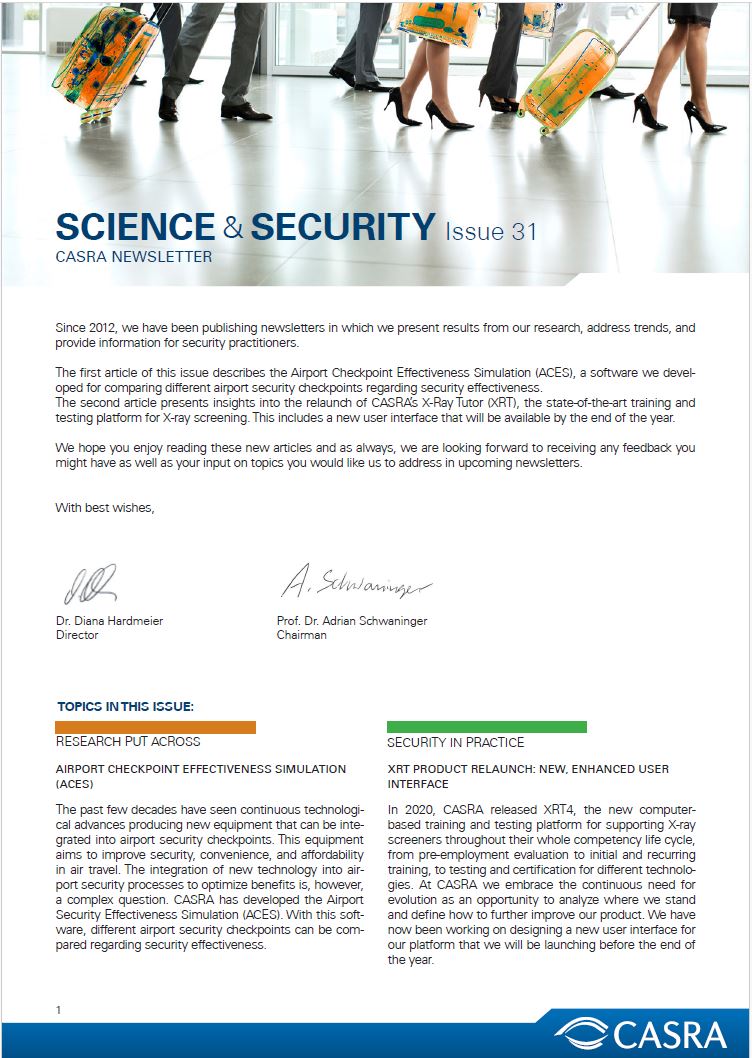
RESEARCH PUT ACROSS
SECURITY IN PRACTICE
training, to testing and certification for different technologies. At CASRA we embrace the continuous need for evolution as an opportunity to analyze where we stand and define how to further improve our product. We have
now been working on designing a new user interface for our platform that we will be launching before the end of the year.
Issue 30 - 2023
CASRA IS CELEBRATING ITS 15TH ANNIVERSARY The Center for Adaptive Security Research and Applications (CASRA) originates from the Visual Cognitive Research Group (VICOREG) of the University of Zurich which was founded back in 1999. In a workshop, each team discussed why CASRA has become so successful and why people like working at CASRA. Several aspects were mentioned by each team: versatility, the people, flexible working hours, remote work, working on interesting projects and tasks, as well as other aspects.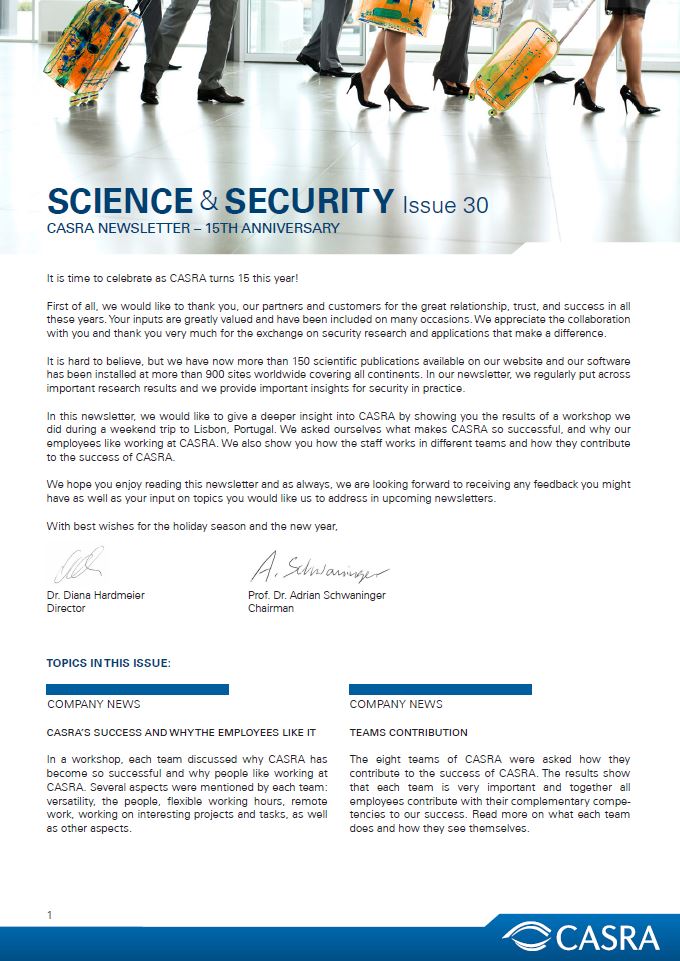
SPECIAL ANNIVERSARY ISSUE
CASRA itself was founded in 2008 and is celebrating its 15-year anniversary this year! Therefore, with this 30th edition of the CASRA Newsletter, we want to take you on a journey spotlighting how we have evolved in these challenging, interesting and successful years until today.CASRA’S SUCCESS AND WHY THE EMPLOYEES LIKE IT
Issue 29 - 2023
SHOULD SECURITY OFFICERS BE LIMITED TO 20 MINUTES OF X-RAY IMAGE SCREENING? European regulation currently restricts the inspection of X-ray or CT images of cabin baggage to 20 minutes of continuous screening. To evaluate whether this duration could be increased, a group of security officers working in remote cabin baggage screening was inspecting images for up to one hour. Results suggest that 30-40 minutes of image inspection seem feasible if security officers can stop early when their concentration wanes. A LOOK BEHIND THE SCENES AT FRASEC: SECURITY AT FRANKFURT AIRPORT Within this interview, Sven Blumenschein, FraSec’s quality officer, gives us in depth insight into their daily operations in 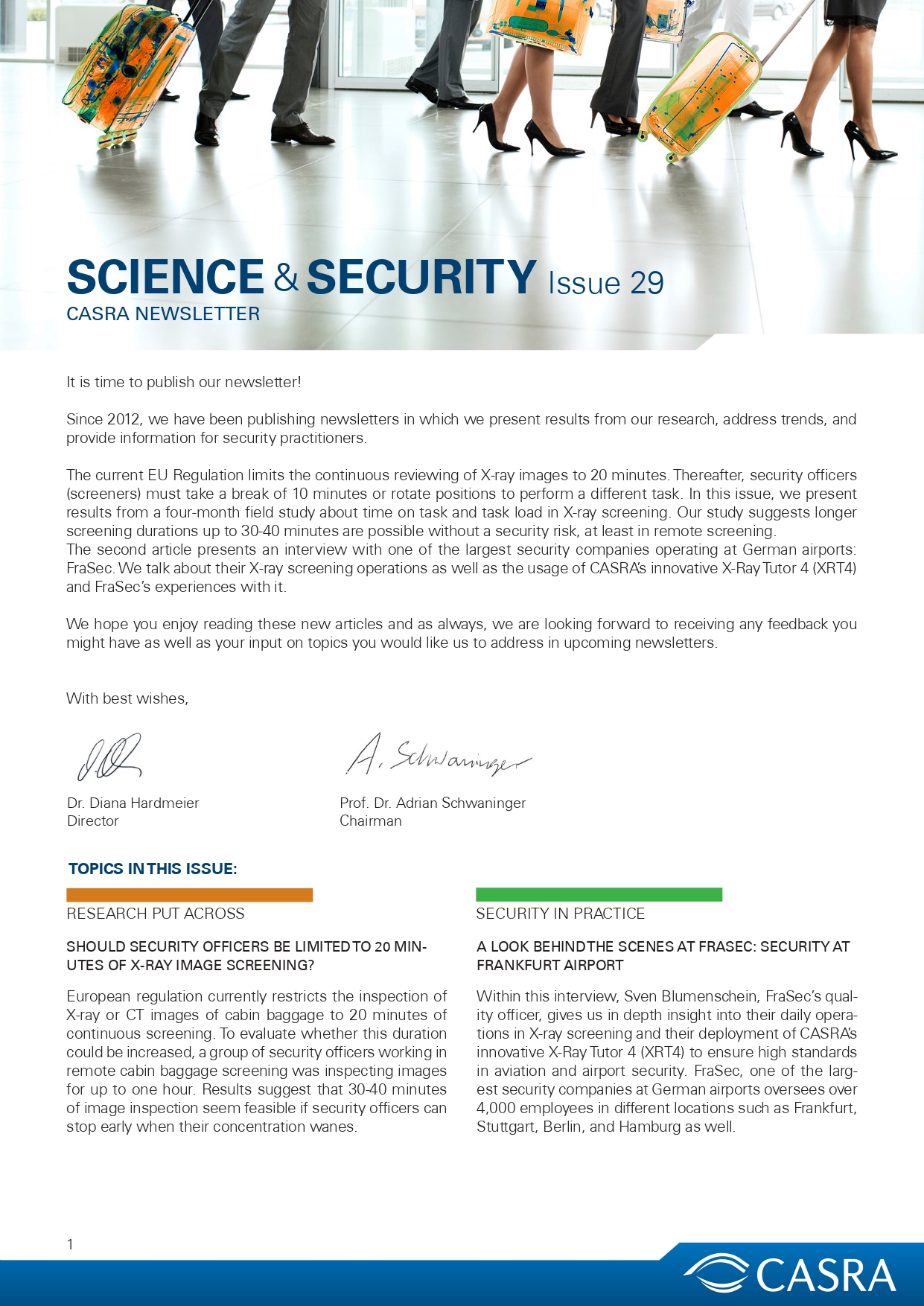
RESEARCH PUT ACROSS
SECURITY IN PRACTICE
X-ray screening and their deployment of CASRA’s innovative X-Ray Tutor 4 (XRT4) to ensure high standards in aviation and airport security. FraSec, one of the largest security companies at German airports oversees over 4,000 employees in different locations such as Frankfurt, Stuttgart, Berlin, and Hamburg as well.
Issue 28 – 2022
COMMERCIALLY AVAILABLE APIDS (AUTOMATED PROHIBITED ITEMS DETECTION SYSTEMS) With the advance of computer vision in recent years, X-ray and CT machines can now be upgraded with APIDS (Automated Prohibited Items Detection Systems). When used in combination with automated explosive detection, it could become possible in the future that primary screening of cabin baggage can be done automatically without the need of human inspection, at least for a share of the baggage. CASRA has surveyed commercial providers of APIDS. The results of this survey are presented in this article. XRT4 - NEW FEATURE - THEORETICAL BLOCK In the past few years, we have been working on our new all-encompassing training and testing solution X-Ray Tutor 4 (XRT4). XRT4 allows you to select, train and test X-ray security officers with single-view, dual-view images as well as 3D computed tomography technology. For enabling people and technology for a safe and secure world even more, we developed a new feature called theoretical block. This allows customers to run various e-learnings, theoretical exams and questionnaires within XRT4.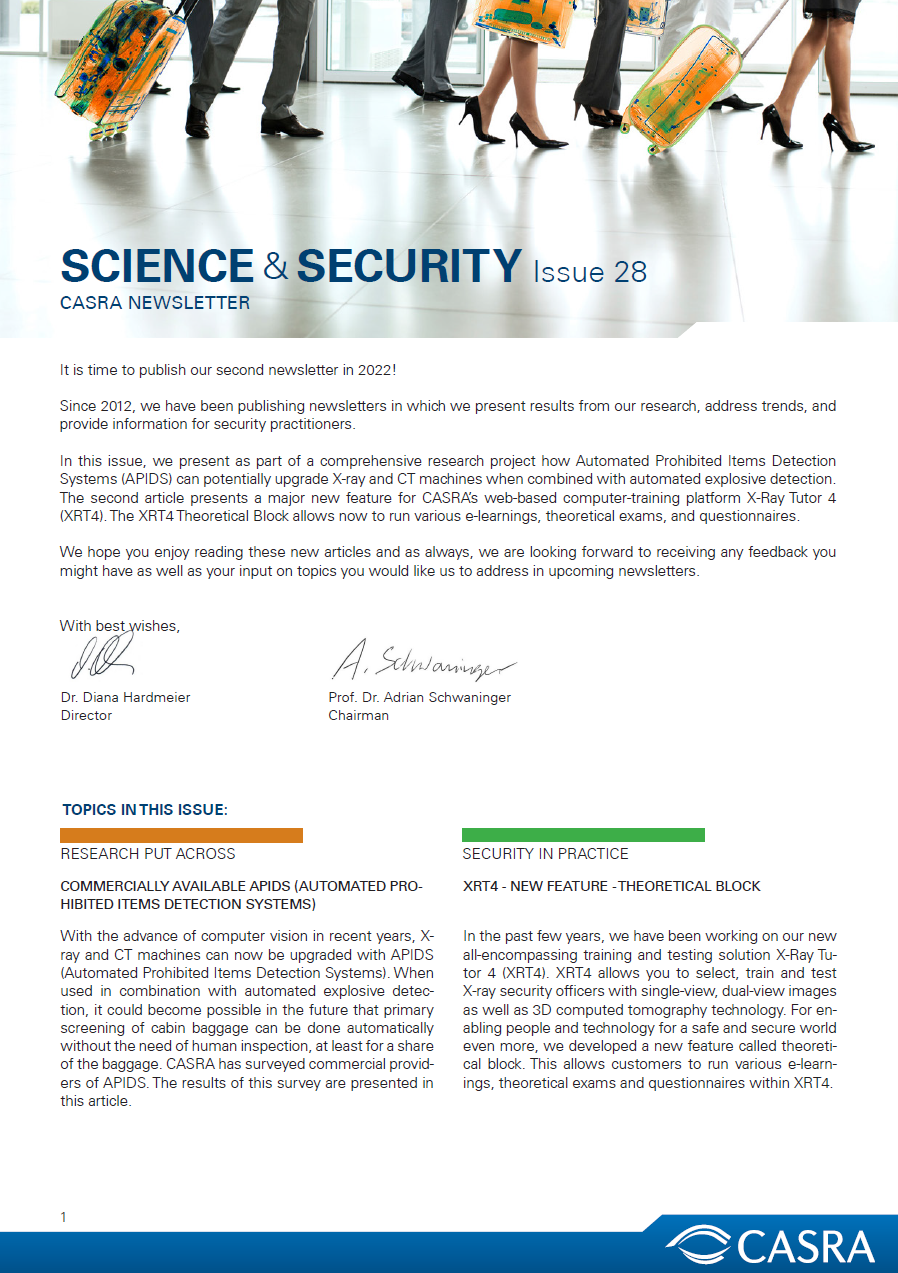
RESEARCH PUT ACROSS
SECURITY IN PRACTICE
Issue 27 – 2022
A SPECIFIC CASE FOR TRAINING IN HIGH ENERGY XRAY IMAGE INTERPRETATION High energy X-ray systems provide several advantages to Customs and border security administrations due to their capability of scanning shipping containers and trucks THE AUSTRALIAN DEPARTMENT OF AGRICULTURE, WATER AND THE ENVIRONMENT’S IMPLEMENTATION OF X-RAY TUTOR 4 IN ITS TRAINING PROGRAM Biosecurity refers to measures aimed at preventing the introduction and/or spread of harmful organisms to animals and plants in order to minimize the risk of transmission of infectious disease. In this interview John O’Brien, National Radiation Manager of the Detection Capability Division with the Australia Department of Agriculture, Water and the Environment will describe the challenge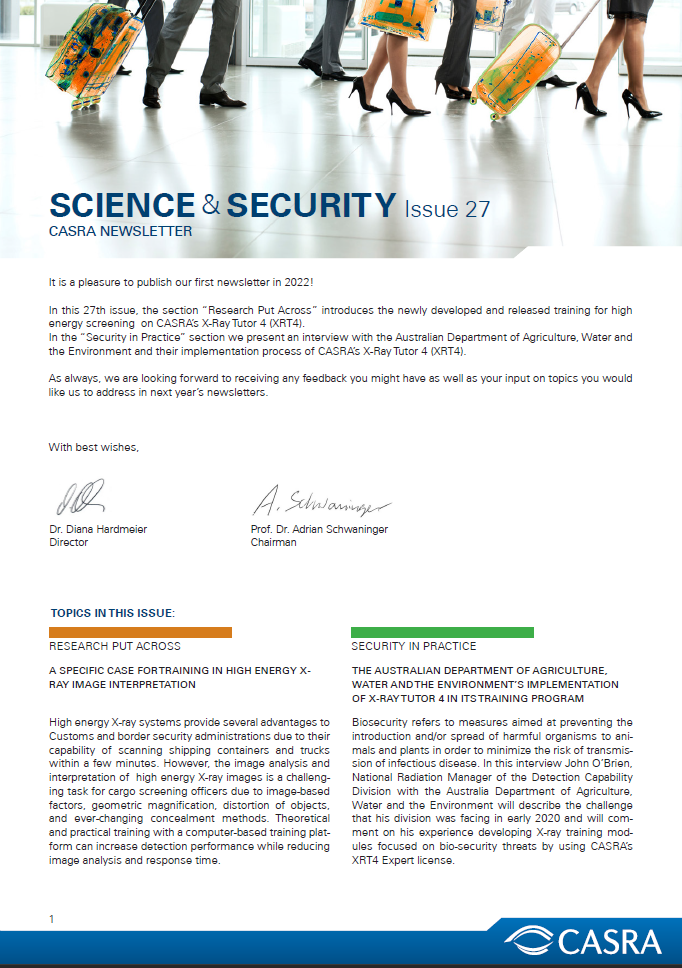
RESEARCH PUT ACROSS
within a few minutes. However, the image analysis and interpretation of high energy X-ray images is a challenging task for cargo screening officers due to image-based
factors, geometric magnification, distortion of objects, and ever-changing concealment methods. Theoretical and practical training with a computer-based training platform can increase detection performance while reducing image analysis and response time.SECURITY IN PRACTICE
that his division was facing in early 2020 and will comment on his experience developing X-ray training modules focused on bio-security threats by using CASRA’s XRT4 Expert license.
Issue 26 – 2021
COMPARING THE EFFECTIVENESS AND EFFICIENCY OF CHECKPOINTS As part of a research and development project, CASRA has developed methods and tools to assist with evaluating the different performance aspects of airport security checkpoints: Security, efficiency, passenger experience, and a work environment that allows for motivated security officers. This article presents one of these tools, which can be used to compare the overall security provided by different checkpoint technologies and configurations. INTERNATIONAL BENCHMARKING FOR X-RAY HOLD BAGGAGE SCREENING This article presents the International Air Transport Association (IATA) X-ray hold baggage screening assessment along with the benchmarking methodology and tool. They were developed and piloted in 2021 within the IATA Innovation in Security – Processes and Technology Workstream#3 led by CASRA. The methodology and tool were developed based on industry contributions and leverage more than 15 years of applied research in the area of human factors in aviation security screening.
RESEARCH PUT ACROSS
SECURITY IN PRACTICE
Issue 25 – 2021
AUTOMATION RELIABILITY, HUMAN–MACHINE SYSTEM PERFORMANCE, The following article covers the CASRA’s investigation of human-machine interaction investigation between airport security screeners and automated explosives detection systems for cabin baggage (EDSCB). The scope of the study was to understand how automation reliability and unaided performance relate to human-machine system performance and operator compliance. INTERNATIONAL CARGO SCREENING STUDY In collaboration with the International Air Transport Association (IATA), and supported by id3 Technologies as well as participants from all over the world, CASRA is delighted to introduce a web-based international cargo screening study. The aim of the study is to illustrate the benefits of computerbased training (CBT) for cargo screening and show its potential for improvements.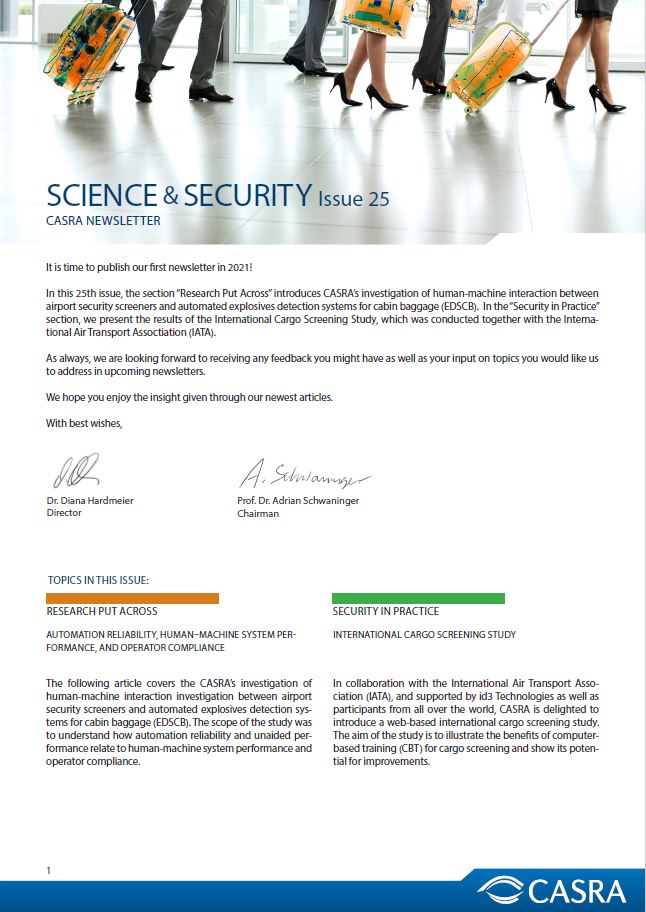
Please subscribe to the newsletter and contact us to receive this issue.
RESEARCH PUT ACROSS
AND OPERATOR COMPLIANCESECURITY IN PRACTICE
Issue 24 – 2020
TRESSPASS PROJECT The following article introduces the TRESSPASS (robusT Risk basEd Screening and alert System for PASSengers and luggage) project, explaining its innovative approach to border control. The overall TRESSPASS concept, its risk assessment methodology and the importance of ethical considerations are discussed, along with an overview of the contributions of CASRA to the project. Subsequently, the domain of training INTERVIEW WITH THE SWISS FEDERAL CUSTOMS ADMINISTRATION (FCA) In our interview, Christian Küng and David Leclerc from the FCA talk about their X-ray screening experiences and theirdaily routines within the country, at the borders, and abroad.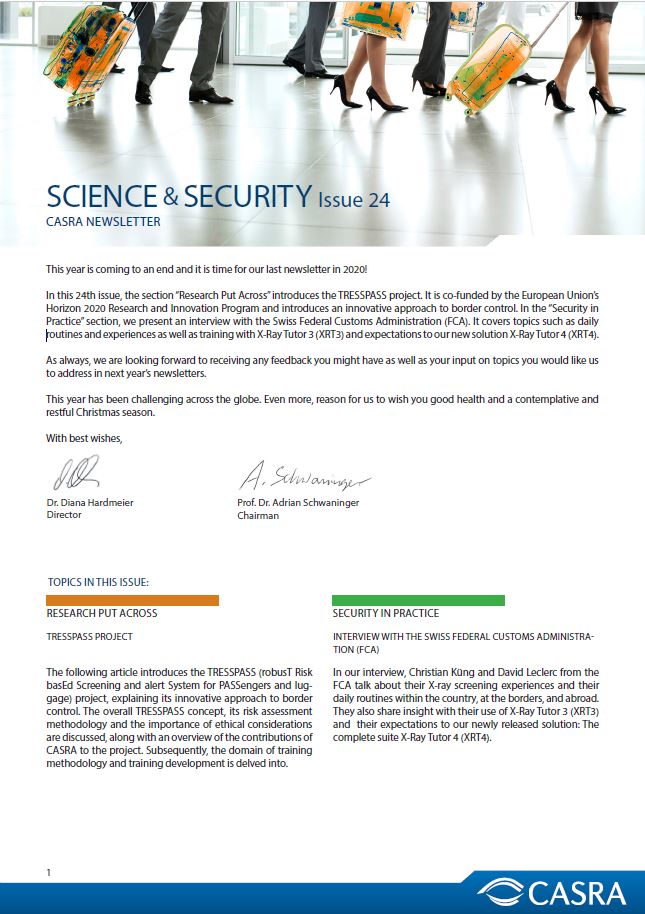
Please subscribe to the newsletter and contact us to receive this issue.
RESEARCH PUT ACROSS
methodology and training development is delved into.SECURITY IN PRACTICE
They also share insight with their use of X-Ray Tutor 3 (XRT3) and their expectations to our newly released solution: The complete suite X-Ray Tutor 4 (XRT4).
Issue 23 – 2020

RESEARCH PUT ACROSS
X-RAY SCREENING OF HOLD BAGGAGE: WHAT VISUAL-COGNITIVE ABILITIES ARE NEEDED FOR 2D AND 3D IMAGING?
The task of an airport security officer is to visually inspect X-ray images of luggage and take a decision within seconds whether it is a harmful piece of baggage or not. While still many airports conduct security screening with 2D multi-view X-ray imaging technology, newer technology is based on 3D CT imaging and brings along new features such as 360° rotation and slicing through the bag. Important to know is: “Are the same visual-cognitive abilities needed for 3D CT image inspections?” This article describes results from a first study and what these results imply for future personnel selection.
SECURITY IN PRACTICE
X-RAY TUTOR 4 (XRT4): BUILT UPON TWO DECADES OF APPLIED RESEARCH
Through continuous improvement, research and strong connections to partners and customers, CASRA presents the new testing and training solution XRT4! The computer-based training, which supports screeners through all the employment phases, incorporates the scientifically proven individually adaptive training algorithm. XRT4 allows to train with single-view, dual-view and 3D CT modules, while adapting the user interface to most common vendors. XRT4 Expert gives even the opportunity to create individual and personalized modules for training and testing. This article explains how the solution has evolved and how the results have been implemented into XRT4.
Issue 21 – 2019

Please subscribe to the newsletter and contact us to receive this issue.
RESEARCH PUT ACROSS
AIRPORT SECURITY X-RAY SCREENING OF HOLD BAGGAGE: 2D VERSUS 3D IMAGING
At airports worldwide, hold baggage is screened using X-ray machines with automated explosive detection. Older systems are based on 2D multi-view X-ray (2D imaging) whereas newer systems are based on computer tomography (CT) that features 3D rotatable images (3D imaging). We compared the visual inspection performance of screeners using 2D imaging versus 3D imaging. Results showed that despite lower image quality of 3D imaging, screeners achieved a similar detection performance with 3D imaging to that for 2D imaging. Screeners required more time for visual inspection of 3D versus 2D images. However, due to lower false alarm rates of 3D imaging systems compared to 2D imaging systems, baggage throughput is still much higher when using 3D imaging in hold baggage screening.
SECURITY IN PRACTICE
SYSTEMATIC THREAT ASSESSMENT
We live in a fast-moving world in which vast amounts of data are produced at an accelerating pace. A systematic analysis of data from the open and deep web allows identifying new and emerging threats against civil aviation at an early stage. With the Systematic Threat Assessment (STA), we monitor large amounts of data in open source media and the deep web using different methods for search, data ingestion, and analysis by applying machine learning algorithms. This allows early threat identification to define immediate countermeasures such as updates to recurrent training for keeping screeners up to date regarding new and emerging threats. In this article, we explain our STA process and countermeasures using concrete examples.
Issue 20 – 2018

SPECIAL ANNIVERSARY ISSUE
CASRA IS CELEBRATING ITS 10TH ANNIVERSARY
The Center for Adaptive Security Research and Applications (CASRA) originates from the Visual Cognitive Research Group (VICOREG) of the University of Zurich which was founded back in 1999.
CASRA itself was founded in 2008 and is celebrating its 10-year anniversary this year! Therefore, with this 20th edition of the CASRA Newsletter, we want to take you on a journey spotlighting how we have evolved in these challenging, interesting and successful years until today.
Issue 22 – 2019
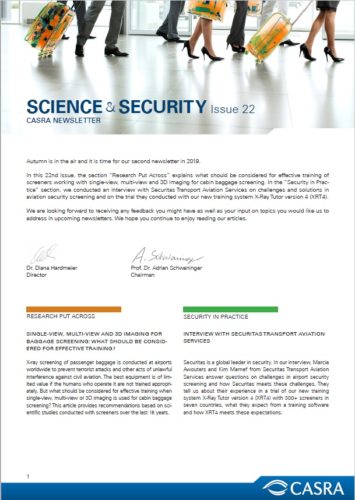
Please subscribe to the newsletter and contact us to receive this issue.
RESEARCH PUT ACROSS
SINGLE-VIEW, MULTI-VIEW AND 3D IMAGING FOR BAGGAGE SCREENING: WHAT SHOULD BE CONSIDERED FOR EFFECTIVE TRAINING?
X-ray screening of passenger baggage is conducted at airports worldwide to prevent terrorist attacks and other acts of unlawful interference against civil aviation. The best equipment is of limited value if the humans who operate it are not trained appropriately. But what should be considered for effective training when single-view, multi-view or 3D imaging is used for cabin baggage screening? This article provides recommendations based on scientific studies conducted with screeners over the last 15 years.
SECURITY IN PRACTICE
INTERVIEW WITH SECURITAS TRANSPORT AVIATION SERVICES
Securitas is a global leader in security. In our interview, Marcia Awouters and Kim Marnef from Securitas Transport Aviation Services answer questions on challenges in airport security screening and how Securitas meets these challenges. They tell us about their experience in a trial of our new training system X-Ray Tutor version 4 (XRT4) with 300+ screeners in seven countries, what they expect from a training software and how XRT4 meets these expectations.
Issue 19 – 2018

Please subscribe to the newsletter and contact us to receive this issue.
RESEARCH PUT ACROSS
SESSION DURATION OF THE X-RAY SCREENING TASK UP FOR DEBATE
“Persons screening cabin baggage by X-ray or EDS equipment shall normally not spend more than 20 minutes continuously reviewing images. After each of these periods, the screener shall not review images for at least ten minutes.” This is mandated by the European Commission implementing Regulation (EU) 2015/1998. To be compliant, screeners working at airport security checkpoints have to change from X-ray screening to another position after 20 minutes. In remote screening, such rotation is operationally more difficult and compliance with the strict tenminute break can be challenging. Therefore, an interest in considering longer X-ray screening durations exists. CASRA has conducted a study to investigate how detection performance changes during 60 minutes of consecutive X-ray screening and what role ten-minute breaks play.
SECURITY IN PRACTICE
TIP DATA ANALYSIS MADE EASY WITH THE CASRA TIP DATA TOOL
Threat Image Projection (TIP) is a technology of current X-ray machines that allows exposing screeners to fictional but realistic X-ray images during the routine baggage X-ray screening operation. TIP is used for several purposes, e.g. to keep security screeners’ motivation and attention at a high level. However, the analysis of a large amount of TIP data by hand is complicated, error-prone and time-consuming. Hence, TIP data analysis could benefit from an automated process. To this end, we developed the CASRA TIP Data Tool, which is integrated into the CASRA Solution, as a means to facilitate the aggregation and to analyze large amounts of TIP data in an efficient and user-friendly, easy-to-use way. Results are presented in detailed and standardized reports. These reports include TIP performances of security personnel, hit rates, non-TIP alarm rates and the number of TIP images shown. Thus, the TIP Data Tool ensures the compliance with the EU’s legal requirements with minimum expenditure of time.
Issue 18 – 2018

Please subscribe to the newsletter and contact us to receive this issue.
RESEARCH PUT ACROSS
3D SIMULATIONS OF AIRPORT SECURITY CHECKPOINTS
Passenger volumes at airports are increasing worldwide and if queues get longer, travelers might start considering other airports or alternative modes of transportation for certain destinations. 3D simulations offer new possibilities to design and evaluate process optimizations. In this article we explain how that can be achieved for airport security checkpoints using a sociotechnical approach.
SECURITY IN PRACTICE
AVIATION SECURITY AT MUNICH AIRPORT
Munich Airport is Germany’s second largest airport and it has received the title “5 Star Airport” from Skytrax in 2015. In our interview, Enrico Eichner from the Government of Upper Bavaria at Munich airport answers questions regarding the organization of aviation security, challenges and solutions. He also addresses training and certification processes of airport security officers at Munich airport.
Issue 17 – 2017

RESEARCH PUT ACROSS
CENTRALIZED IMAGE PROCESSING AT CHECKPOINT SECURITY – IMPACTS OF VARIOUS IMPLEMENTATION POSSIBILITIES
Remote screening of hold baggage based on centralized image processing (CIP) has been in use since the beginning of this century and is the common practice at larger airports. Remote screening of cabin baggage, however, is relatively new, with first projects having started around eight years ago. Introducing CIP at security checkpoints has the potential to dramatically increase an airport’s capacity and the efficiency of passenger screening and is therefore a valuable option to tackle the increasing air passenger traffic numbers, which according to IATA , are forecasted to double by 2035. An analysis conducted by CAS RA of previous experiences by pioneers and early adopters of CIP for checkpoint security has shown that a well-planned and thoroughly evaluated CIP implementation is critical for success. This article will give an introduction and overview of CIP, discuss the potential benefits and pitfalls to look out for and compare different CIP implementation possibilities regarding effectiveness, efficiency and human factors.
SECURITY IN PRACTICE
SCREENING PROCESSES AND FUTURE VISION - AN INTERVIEW WITH AVSEC NEW ZEALAND
The Aviation Security Service (Avsec) is a government agency (crown entity) and acts as the official provider of aviation security in New Zealand (NZ). Avsec NZ has a station at each of the five international airports located at Auckland, Wellington, Christchurch, Queenstown and Dunedin. In an interview, Karen Urwin - Group Manager of Operations at Avsec - answers questions regarding their training and certification processes as well as testing new and innovative solutions in terms of X-ray screening. She also talks about the “hot topics” concerning new and emerging threats and how Avsec NZ reacts to them.
Issue 16 – 2017

RESEARCH PUT ACROSS
X-RAY IMAGE QUALITY AND THE USEFULNESS OF IMAGE ENHANCEMENT FUNCTIONS
The importance of X-ray image quality and image enhancement functions for the visual inspection of passenger bags has been investigated and discussed in different scientific studies, mainly for airport security screening. Also for other domains, such as security screening at critical infrastructures, it is assumed that a good X-ray image quality and the availability of different image enhancement functions are important for screeners to achieve good performance in detecting prohibited items. Therefore, Smiths Detection asked CAS RA to investigate the usefulness of an optimized default image and of the further developed image enhancement functions for the new X-ray machine HI-SCAN 6040C in a scientific study. In addition, the question of how security officers (operators) perceive an optimized background contrast, which is available on that machine, was addressed. Finally, relevant aspects such as how operators normally proceed when analyzing X-ray images, which image enhancement functions are used and how often, were explored.
SECURITY IN PRACTICE
INTERDICTING SMALL ARMS IN POSTAL SHIPMENTS (ISAPS)
Latin America and the Caribbean have, in general terms, experienced a dramatic increase in armed violence in recent years, driven in large part by the illicit trafficking of firearms, its parts/components, and ammunition. Public policies against illicit arms trafficking in Latin America and the Caribbean have led toan increased use of X-ray technology for the screening of postal shipments. Thus, states have called on the United Nations Regional Centre for Peace, Disarmament and Development in Latin America and the Caribbean (UNLIREC) to provide specialized interdiction tools and X-ray screening training to help combat illicit arms trade by developing a Course for Interdicting Small Arms in Postal Shipments (ISA PS). The project’s main goal is to boost the capacity of Latin American and Caribbean states to reduce the distribution of illicit arms and their parts/components via postal shipments. Crucial milestones of the project were the development of an Arms, Ammunition, Parts and Components Identification Guide in collaboration between UNLIREC and CAS RA, and a pilot course and study in Costa Rica.
Issue 15 – 2017

Please subscribe to the newsletter and contact us to receive this issue.
RESEARCH PUT ACROSS
HOW USEFUL ARE ASSIS TED TARGET RECOGNITION ALGORITHMS AND TRAINING FOR IMPROVING THE DETECTION PERFORMANCE OF CUSTOMS OFFICERS?
In the CAS RA Newsletter one year ago (Issue 12, March 2016), we have described AC XIS (Automated Comparison of X-ray Images for Cargo Scanning). This is a research project funded by the European Union under the 7th framework program with the main aim to increase effectiveness and efficiency of cargo screening at customs. Among other tasks, the project researched and developed assisted target recognition (AT R) algorithms to assist customs officers in the challenging search for illicit goods in cargo containers. With the final decision of whether a container should be opened for further investigation still in the responsibility of the officers, the detection performance of the AT Rs is not the only determinant of their benefit. Also the successful interaction between the officers and the AT Rs is crucial for the joint performance. This joint performance was investigated in a validation study, also considering the importance of training for detection performance.
SECURITY IN PRACTICE
IS EVERYDAY OBJECT KNOWLEDGE RELATED TO XRAY SCREENERS’ EFFECTIVENESS AND EFFICIENCY?
The main objective of CAS RA is to increase security and facilitation at airports and other environments involving people and technology, using an adaptive approach by combining applied psychology and computer science. Learning which objects are prohibited and what they look like in X-ray images of passenger bags is important for X-ray screeners to achieve a good detection in visual inspection of passenger bags. However, as these bags also contain a large variety of harmless everyday objects, it could be assumed that knowing how such objects look like in X-ray images might help screeners to work better. CAS RA researchers conducted a scientific study to investigate whether the knowledge of everyday objects is related to X-ray screeners’ effectiveness and efficiency (Experiment 1) and if novices’ everyday object knowledge can be trained (Experiment 2).
Issue 14 – 2016

Please subscribe to the newsletter and contact us to receive this issue.
RESEARCH PUT ACROSS
EMOTIONAL EXHAUSTION, JOB SATISFACTION AND WORK − FAMILY CONFLICT IN AIRPORT SECURITY OFFICERS
Situational factors such as task sequence, work environment and team interactions have proven to affect the performance of airport security officers. However, previous research has not focused on the relationship between specific work characteristics and other factors, such as emotional exhaustion. A recently published study has addressed this gap by examining the effects of work-family conflict as intervening variable in the job demands resources model between workload, supervisor support, emotional exhaustion and job satisfaction in 1’127 airport security officers at a European airport.
SECURITY IN PRACTICE
CASRA E-LEARNING MODULES FOR KEEPING AIRPORT SECURITY OFFICERS UP-TO-DATE REGARDING CURRENT, NEW AND EMERGING THREATS
Computer-based training is a widely used effective and efficient tool to achieve and maintain high levels of detection of prohibited items in X-ray images by airport security officers. For certain current, new and emerging threats, screeners may also benefit from conceptual and contextual knowledge, e.g. on current trends to hide improvised explosive devices in passenger bags. E-learning modules that combine images, textual content and interposed questions can be a valuable addition to X-ray image interpretation training. In this article, we explain important scientific principles and show examples of how to use this training method.
Issue 13 – 2016

Please subscribe to the newsletter and contact us to receive this issue.
RESEARCH PUT ACROSS
DETERMINANTS OF AIRPORT SECURITY X-RAY SCREENERS’ DETECTION PERFORMANCE
In this article, determinants of airport security X-ray screener’s detection performance are discussed from a scientific and practical point taking into account research we have conducted in the last 15 years. Scientifically validated selection tests, effective and efficient computer-based training, high quality certification tests, threat image projection and practical tests are important enablers for good detection performance results when implemented properly.
SECURITY IN PRACTICE
THE CUSTOMS X-RAY SIMULATOR – A NEW TESTING AND TRAINING PLATFORM FOR CUSTOMS OFFICERS
CASRA has developed a new platform for cargo X-ray image interpretation training and testing, called the Customs X-Ray Simulator. This system was specifically designed for cargo X-ray screening officers by CAS RA in close collaboration with customs organizations and other partners in the EU 7th Framework project AXCIS. In our article, we describe challenges when interpreting cargo X-ray images and show how the Customs X-Ray Simulator works.
Issue 12 – 2016

Please subscribe to the newsletter and contact us to receive this issue.
RESEARCH PUT ACROSS
AUTOMATED COMPARISON OF X-RAY IMAGES FOR CARGO SCANNING
ACXIS (Automated Comparison of X-ray Images for cargo Scanning) is a research project funded by the European Union under the 7th framework program. The continuously growing cargo industry with an ever increasing amount of goods passing checkpoints requires efficient inspection procedures. This not only poses challenges to international logistics providers but is also crucial to the customs authorities. The aim of the project is to provide automated detection techniques of threats and illicit goods through dedicated algorithms and to develop a reference database for X-ray scans of illegal and legitimate cargo.
SECURITY IN PRACTICE
USING THE CASRA SOLUTION DOWN UNDER – AN INTERVIEW WITH MSS SECURITY AUSTRALIA
Every year, MSS Security airport officers screen 18 million passengers, 15 million checked bags, and a large proportion of air freight leaving Australia. Over the past year, CASRA has had the opportunity to collaborate with MSS Security on several initiatives. These included the introduction of our training program X-Ray Tutor 3 (XRT3) along with the pre-employment assessment tool X-Ray Object Recognition Test (X-Ray ORT), both of which are part of our modular CASRA Solution. In our interview, Marjie Bramham, Aviation Compliance Training and Development Manager at MSS Security, tells us about working with the CASRA team. She also talks about the customer-centric approach to creating a secure environment in Australian airports and what the current “hot topics” are among Australian security experts.
Issue 11 – 2015

RESEARCH PUT ACROSS
XP-DITE – INTRODUCING A SYSTEM LEVEL APPROACH TO EVALUATING AIRPORT SECURITY CHECKPOINTS
Security checkpoints pose central elements at airports across the world today. Their design, technical equipment, and processes determine security, throughput, and passenger satisfaction. However, as of today, airport security checkpoints are neither developed, nor evaluated in a holistic manner. Equipment and staff are extensively tested and certified, but the performance of the system as a whole is rarely taken into account from the start, nor is it consistently evaluated. The EU FP7 project XP-DITE aims at changing this.
SECURITY IN PRACTICE
CERTIFICATION PILOT STUDY WITH THE CROATIAN CIVIL AVIATION AGENCY (CCAA)
In aviation security, even the best technology is ineffective without competent personnel who can put its functions to use. Thus, as much attention should be devoted to the human operator as to technological innovations. This involves a reliable selection process, sound training of personnel, and the periodical verification of the respective competencies. This article describes the practical implementation of a certification procedure conducted collaboratively with the Croatian Civil Aviation Agency (CCAA).
Issue 10 – 2015

SPECIAL ISSUE
CASRA BEHIND THE SCENES:
PROCESSES, PEOPLE, AND THE CASRA SPIRIT & INTERVIEW WITH FORMER HEAD OF ZURICH STATE POLICE, AIRPORT DIVISION WERNER H. WÜEST,
Three years ago, the first issue of Science & Security was published. Since then, the CASRA newsletter has taken you on a “tour d’horizon” of our research and development activities. We have shown you different facets of what we do and why we do it. We have also provided you with one or the other insight into how we work.
In the 10th issue of Science & Security, we decided to make the how our main focus. This newsletter takes you behind the scenes of our center and shows you how we do things to achieve our main objective: to increase security and facilitation at airports and in other environments involving people and technology. We are happy that several of our employees contributed short texts on their areas of expertise included in infoboxes.
We also took the opportunity to interview one of Switzerland’s most experienced security experts – Werner H. Wüest – the former head of Zurich State Police, Airport Division, Security Control Branch at Zurich Airport. He has cooperated with CASRA and its organizational predecessors over many years in different projects.
Issue 09 – 2015

Please subscribe to the newsletter and contact us to receive this issue.
RESEARCH PUT ACROSS
APPROACHING SECURITY FROM ANOTHER ANGLE – BEHAVIORAL SECURITY SCREENING
Security screening processes at airports are still mainly focused on finding prohibited items. However, a growing number of authorities worldwide are interested in security measures at airports that also focus their attention on malicious intent: Trained personnel are scanning travelers for suspicious behavioral cues to identify wrongdoers. However, the question what form such a behavioral security screening (BSS) program should take or how it should be implemented is still in an investigation phase. CASRA conducted an 18-months scoping study, leading to the recommendation of a six-step process to BSS program implementation.
SECURITY IN PRACTICE
SYSTEMATIC THREAT ASSESSMENT: HOW TO ADAPT SECURITY MEASURES BASED ON THE RESEARCH ON LATEST THREATS
To prevent acts of unlawful interference against civil aviation, knowledge about new threats is of fundamental importance when it comes to the adaption of security measures in an efficient and effective way. But which sources have to be tapped into and how must different emerging threats be weighted? CASRA developed and implemented a Systematic Threat Assessment (STA) to detect and prioritize latest threat scenarios and to develop appropriate defense strategies.
Issue 08 – 2014

Please subscribe to the newsletter and contact us to receive this issue.
RESEARCH PUT ACROSS
SECURITY CHECKPOINTS: WHICH SITUATIONAL FACTORS INFLUENCE THE SCREENING TASK?
Security operators’ (screeners) primary work task at the airport security checkpoint is to inspect X-ray images and to decide whether or not the passenger bag is containing a prohibited item. Their performance is of high importance for the overall security of the air transportation system. A recent study by CASRA examined different situational factors and their influence on the screeners’ primary work task.
SECURITY IN PRACTICE
ADAPTING X-RAY TUTOR TO SPECIFIC REQUIREMENTS: A CASE STUDY WITH THE SWISS ARMED FORCES
The Swiss Federal Department of Defense, Civil Protection and Sport (DDPS) is responsible for the protection of Switzerland, its inhabitants and infrastructure. In 2012, the DDPS approached CASRA with the request to integrate the X-Ray Tutor into their internal Learning Management System. For this purpose, very specific adaptations had to be made. This article is going to present to you what it took.
Issue 06 – 2014

Please subscribe to the newsletter and contact us to receive this issue.
RESEARCH PUT ACROSS
WORKING CONDITIONS AND EMPLOYEE HEALTH: INVESTIGATING IMPORTANT DETERMINANTS OF SCREENER PERFORMANCE
Despite the availability of modern and advanced security technologies, human resources (screeners) at airport security checkpoints are of crucial importance for the inspection of baggage and passengers. Screeners have to make highly relevant decisions in a challenging work environment. This article analyzes relevant situational factors that influence work performance of cabin baggage screeners and provides starting points on how to maintain and improve performance, i.e. security and efficiency, through the enhancement of working conditions.
SECURITY IN PRACTICE
MANAGING COMPUTER-BASED TRAINING OF X-RAY IMAGE INTERPRETATION AT APPROXIMATELY 80 AIRPORTS – A REPORT FROM CANADA
Wide-area network connectivity is nowadays rather the rule than the exception in large organizations. But how does it work if you need to manage X-ray image interpretation training of 5,000 screening officers at approx. 80 airports in six time zones? The Canadian Air Transport Security Authority (CATSA) allowed us an insight into challenges and solutions.
Issue 05 – 2013

Please subscribe to the newsletter and contact us to receive this issue.
RESEARCH PUT ACROSS
USABILITY – THE KEY TO GETTING THINGS DONE RIGHT ON THE FIRST ATTEMPT
These days, people constantly use software in all aspects of life - and that includes people who claim not to own a computer. We use software when we purchase train tickets, when we browse the World Wide Web, when we set the alarm clock, and so on. With software so prevalent in our lives, it is very important to make software easy to use for all sorts of people who may interact with it.
SECURITY IN PRACTICE
KEY PERFORMANCE INDICATORS FOR SECURITY SCREENING
You can only manage what you can measure. This article summarizes the results of a survey conducted in different countries on key performance indicators (KPIs) used in airport security. Based on the survey results and CASRA’s research experience a set of KPIs for security screening is proposed.
Issue 04 – 2013

Please subscribe to the newsletter and contact us to receive this issue.
RESEARCH PUT ACROSS
INCREASING X-RAY IMAGE INTERPRETATION COMPETENCY OF CARGO SECURITY SCREENERS
In the past years, security measures were increased for passengers, while cargo security did not receive a similar level of attention. A terrorist attack in the field of cargo could highly impact the world’s economy, commerce or the global supply chain. Therefore, container security, but also contraband interdiction in air cargo and cargo shipping are becoming highly relevant topics at ports and airports all over the world. X-ray screening of cargo plays an important role in the security chain. In this article a scientific study is presented which examined the value of computerbased training for increasing X-ray image interpretation competency of cargo screeners.
SECURITY IN PRACTICE
X-RAY SCREENING AT PRISONS
You are not allowed to bring your mobile phone, your camera, a USB stick or for instance some aspirin. This is the situation encountered by visitors to a prison in Switzerland and in many other countries. The complete list of prohibited items is much longer, but the examples already show that security controls in prisons are different to security controls at airports. This article illustrates how CASRA cooperates with experts and end-users to create efficient and effective computer-based training tailored to the area of application.
Issue 07 – 2014

Please subscribe to the newsletter and contact us to receive this issue.
RESEARCH PUT ACROSS
THE DOHA INTERNATIONAL AIRPORT AND HAMAD INTERNATIONAL AIRPORT PROJECT
CASRA’s main aim is to increase security and facilitation at airports and in other environments involving people and technology. In the past decade, CASRA researchers have been able to conduct numerous applied research projects with partners who share this aim, many of them on a long-term basis. An example for a successful long-term collaboration is the research and development project conducted by CASRA scientists in Doha together with the Civil Aviation Authority of the State of Qatar.
SECURITY IN PRACTICE
SECURITY IN PRACTICE USING THE CASRA TESTING PLATFORM (CTP)
Tests are common in every area of life: They are necessary whenever we have to prove that we possess certain abilities, that we have learned something or that we are able to put newly acquired skills to practical use. Based on scientific know-how and several projects with regulators, airports and security companies, the CASRA Testing Platform (CTP) was developed. It allows testing X-ray image interpretation competencies and the theoretical knowledge of screeners in an effective, efficient and flexible way.
Issue 02 – 2012

RESEARCH PUT ACROSS
PAPER ON BLENDED LEARNING AT THE IEEE INTERNATIONAL CARNAHAN CONFERENCE ON SECURITY TECHNOLOGY
Scientific conferences on security related topics are important platforms for information exchange and innovation. This year, a delegation of CAS RA once again participated at the IEEE International Carnahan Conference on Security Technology (IEEE ICCST) and presented two papers. One of them, a study on the application of blended learning in air cargo security, is summarized in this issue. The second paper will be presented in the next issue of Science and Security.
SECURITY IN PRACTICE
COMPUTER BASED TRAINING FOR SECURITY OFFICERS – WHAT SHOULD BE CONSIDERED?
Computer based training (CBT) for security officers is an important topic to be considered for every security provider. This article explains the benefits of CBT, which CBT offers the biggest advantages and which aspects should be taken into account when deciding on a particular system.
Issue 01 – 2012

RESEARCH PUT ACROSS
FROM VISION RESEARCH TO A WIDELY USED TOOL FOR SELECTION: IMAGE-BASED FACTORS AND THE X-RAY OBJECT RECOGNITION TEST
Not every person can become a good and efficient security screener. The questions relevant for personnel selection are: which abilities are needed for efficient visual inspection of X-ray images, and how can they be tested before employing someone? Vision research has led to important insights which resulted in a widely used test for pre-employment assessment and selection.
SECURITY IN PRACTICE
SECURITY OFFICER CERTIFICATION: “MORE TO IT THAN MEETS THE EYE”
Security officer certification is legally required in the EU, confronting member states with the challenge to design certification tests and implement a certification process. Three steps for test design and a range of best practices ensure the adherence to high scientific and psychological standards.
Issue 03 – 2013

Please subscribe to the newsletter below and contact us to receive this issue.
RESEARCH PUT ACROSS
SECURITY CHECKPOINTS: SHOULD LAPTOPS REALLY BE SCREENED SEPARATELY?
Whether travelling on business or privately, a large number of passengers using air transport carry laptops and similar electronic devices such as tablets. Most of us are familiar with the procedure of having to remove these items from our bags at security checkpoints, so they can be screened separately. But what is the actual reason for this? And is this really necessary? One goal of the scientific study described in this article is to shed light on these questions.
SECURITY IN PRACTICE
X-RAY SCREENING TO ENSURE NUCLEAR FACILITY SECURITY – A REPORT FROM OSKARSHAMN
Due to the potentially high impact of theft, sabotage, unauthorized access, or other malicious acts involving nuclear material, nuclear facility security is a topic of high importance. X-ray security screening is employed at many nuclear power plants as a crucial layer of security. Our report from the Swedish nuclear power plant Oskarshamn delivers insight into the business of X-ray security screening in a different environment than air transportation security.





